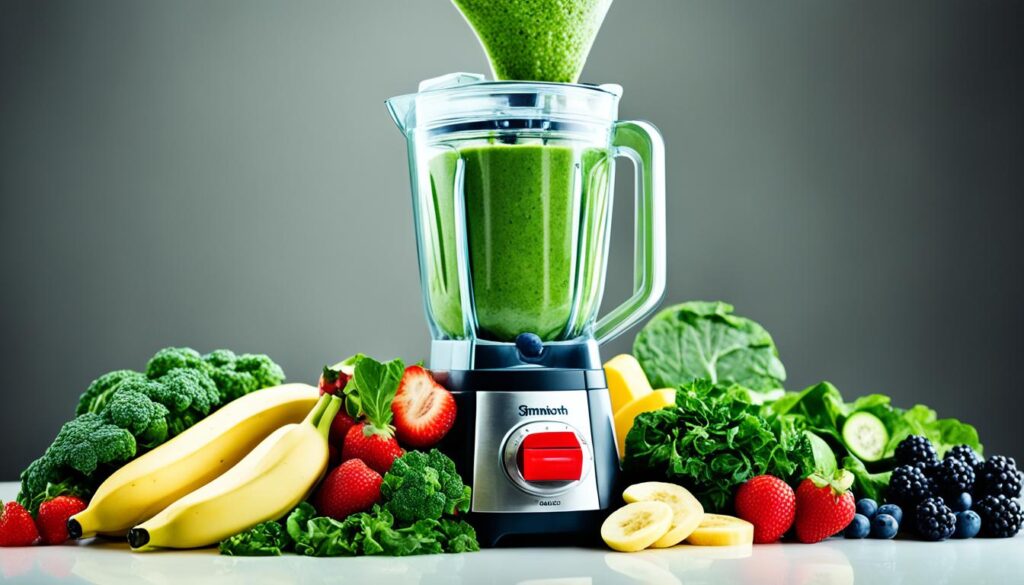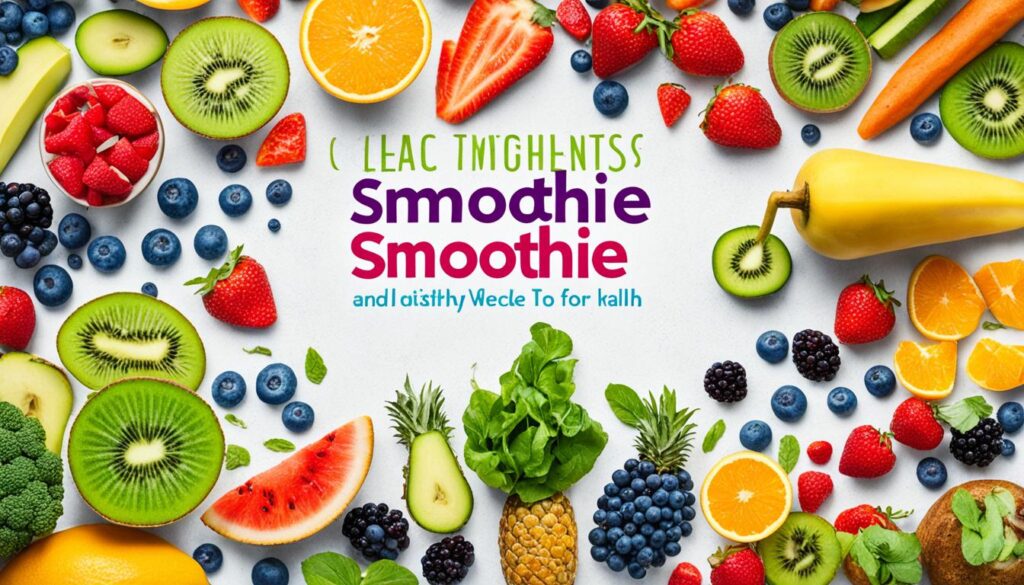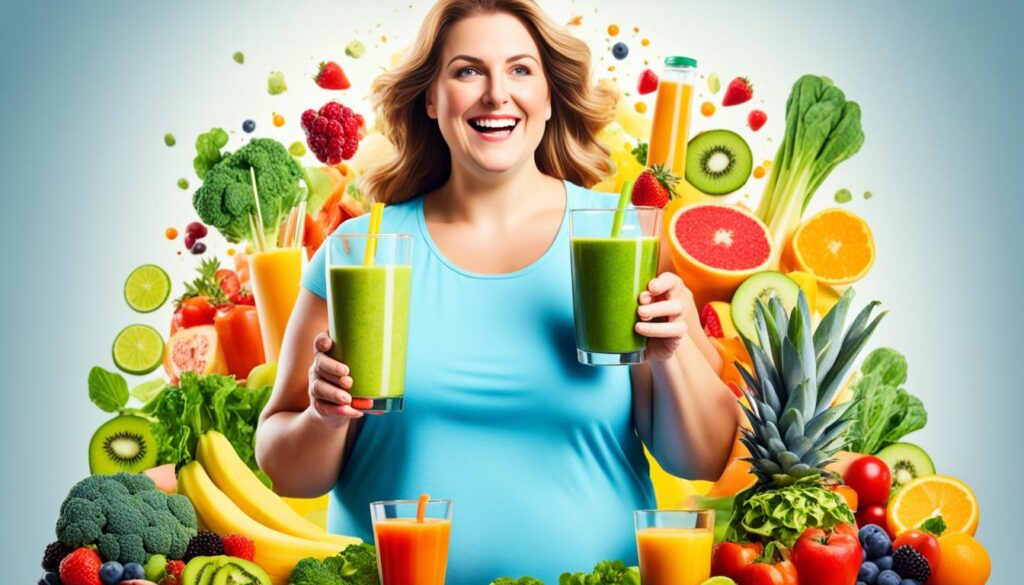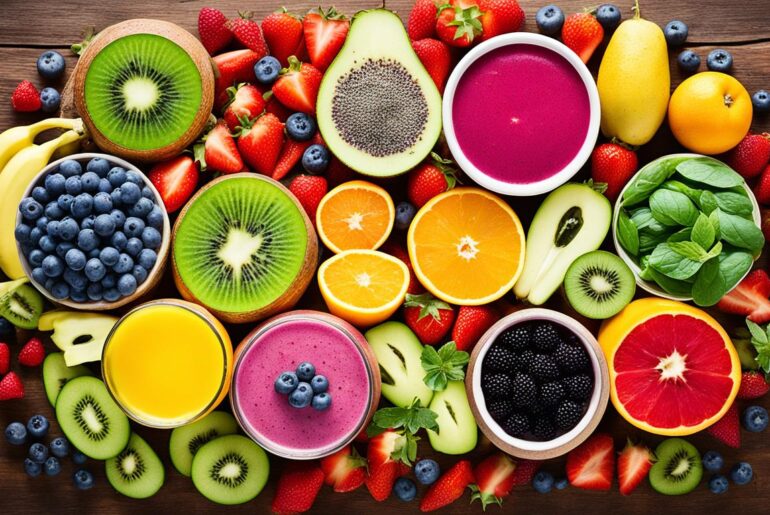About 42.4% of adults and 19.3% of kids in the U.S. are obese. This shows we need good ways to manage weight. The Smoothie Diet is a simple, healthy plan that’s getting popular. It offers health benefits and helps lose weight.
The Smoothie Diet is a great way to lose weight. It promises better sleep, more energy, stronger immunity, and clear skin. You replace two meals a day with smoothies. Plus, you eat one balanced meal and two snacks. This diet is based on whole foods and cuts calories for weight loss.
But, it’s key to think about long-term use and the risk of not getting all nutrients.
Key Takeaways
- Obesity affects 42.4% of adults and 19.3% of children and adolescents in the U.S.
- The Smoothie Diet replaces two meals a day with smoothies to create a calorie deficit for weight loss.
- It promises benefits such as improved sleep, increased energy, and enhanced immunity.
- This diet should be balanced with a solid meal and snacks to avoid nutritional deficiencies.
- Long-term sustainability and monitoring are crucial to avoid potential health risks.
Introduction to the Smoothie Diet
The Smoothie Diet has become very popular, especially for losing weight. It is simple yet effective for dropping pounds and getting healthier. Let’s explore what the Smoothie Diet is and how it became a favorite choice.
What is the Smoothie Diet?
Health coach Drew Sgoutas created the Smoothie Diet. It is a 21-day plan that uses smoothies to replace regular meals. The plan includes many tasty recipes to meet everyone’s needs. Each day, you drink two smoothies instead of eating regular meals. You also have one solid meal and two snacks. The diet focuses on whole foods. This ensures you get all the nutrients you need while eating fewer calories to lose weight.
History and Popularity
The Smoothie Diet has gained many fans because of its simple idea. Using smoothies full of nutrients as meal replacements is not new. But Drew Sgoutas made this idea easy for everyone to follow. Stories of successful weight loss, like Jade losing 12 pounds in 21 days, have made it more popular. People love the tasty and effective smoothie recipes for losing weight.
Many reasons explain the Smoothie Diet’s success. Research shows how important dietary fiber and protein are for controlling weight. The diet includes many fruits, vegetables, and protein. This makes it good for managing your weight. The smoothies are also quick to make. This makes it simpler for people to follow the plan.
In summary, the Smoothie Diet is well-liked because it’s simple, works well, and the smoothies taste great. This has made it a top choice for people looking to lose weight with smoothies.
The 21-Day Smoothie Diet Explained
The 21-Day Smoothie Diet helps you lose weight and improves your health. It replaces two daily meals with smoothies. These are made from fruits, vegetables, and proteins. This helps create a calorie deficit which is key for weight loss. Let’s explore how this diet works and how to follow it effectively.
Overview of the 21-Day Plan
This plan replaces two main meals with fat-burning smoothies. It includes a shopping list and a guide for smoothie prep. The diet costs $27, down from $47, and comes with a 60-day refund policy. There are bonuses like a 3-Day Detox and a Quick-Start Guide too.
Smoothies in this diet use natural ingredients. Customers love this diet, giving it a 4.6 out of 5 satisfaction score. The program provides 36 smoothie recipes, covering various nutritional needs. It’s easy and safe to follow.
How to Follow the 21-Day Smoothie Diet
To follow this diet, replace two meals a day with smoothies. You also eat a solid food meal and snacks. The diet starts with an optional detox. There’s a cheat day every week for balance. Eating healthy one day a week is recommended too, with a provided food list.
Smoothies mix fruits, veggies, some protein, and healthy fats. Not all smoothies have enough protein, though. The USDA recommends 1,500 calories daily, but these smoothies might have less. This can lead to quick weight loss initially. But, it’s important to know, you might gain weight back when you stop the diet.
The benefits of this smoothie diet include detoxification and managing cravings. It’s important to adjust the diet for any food allergies. With careful planning and healthy eating, this diet can provide lasting health benefits.
Key Benefits of the Smoothie Diet
Starting a smoothie diet improves health in many ways. It’s great for losing weight or helping digestion. Smoothies are full of nutrients and fiber that are essential.

Weight Loss Benefits
One top perk of this diet is its help with weight loss. Replacing meals with smoothies cuts calories but still delivers vital vitamins and minerals. This can lead to losing weight. Smoothies made with low-calorie, filling ingredients help in this diet’s success.
Improved Digestion
Smoothies are great for the gut because of their fiber. This fiber eases digestion and helps manage blood sugar. It supports a healthy gut. Adding fruits, veggies, and dairy to smoothies boosts fiber intake. This helps the digestive system work well.
Enhanced Energy Levels
Eating more fruits and vegetables through smoothies ups energy levels. These nutritious drinks give the body energy efficiently, avoiding sugar crashes. It keeps you productive all day. This illustrates the diet’s health benefits.
Studies back up these benefits. Bates & Price (2015) found that smoothies increase fruit eating among teens. Eating lots of fruits and veggies lowers the risk of diseases like diabetes and heart issues (Slavin & Lloyd, 2012).
High-Fiber Smoothie Recipes for Weight Loss
Looking to try The Smoothie Diet for health? Adding high-fiber foods to your smoothies is key. They slow digestion and keep you feeling full. This helps manage weight well.
The Role of Fiber in Weight Loss
Studies show fiber is good for your digestive system. It also helps control blood sugar and lowers cholesterol. With a big obesity problem in the U.S., fiber’s role is crucial. It makes you feel full and helps prevent overeating.
Top High-Fiber Ingredients
Adding high-fiber foods to smoothies can aid your weight loss. Good sources include:
- Fruits and Vegetables: Apples, berries, bananas, avocado, spinach, cucumbers
- Nuts and Seeds: Chia seeds, flaxseeds, almonds
- Whole Grains: Oats, quinoa
- Legumes: Beans, lentils
Imagine a smoothie with chia seeds, spinach, avocado, and Greek yogurt. It gives you fiber, protein, and healthy fats. The AHA suggests keeping frozen fruits and veggies handy. The CDC also advises getting plenty of fiber, along with calcium, vitamin D, and potassium.
By choosing these healthy ingredients, making The Smoothie Diet fun and effective is easy.
Smoothie Diet for Better Heart Health
A smoothie cleanse can do more than help you lose weight. It can also be great for your heart. The trick is to use the right ingredients. These should boost heart health and cut the risk of heart disease.

Heart-Healthy Ingredients
Smoothies that are good for your heart have special ingredients. They are rich in fiber, have omega-3 fatty acids, and are packed with antioxidants. These help lower bad cholesterol, cut blood pressure and fight off harmful inflammation.
- High-Fiber Ingredients: Oats, chia seeds, and berries have lots of fiber. They help you stay full for a long time.
- Omega-3 Fatty Acids: Flaxseeds and chia seeds are top sources of omega-3s.
- Antioxidants: Berries have a ton of antioxidants. They battle oxidative stress and inflammation.
Greek yogurt is a great smoothie add-on. It’s got more protein than regular yogurt. Plus, it’s packed with good probiotics for your gut. Whey protein is also a good choice. It’s easily absorbed and helps fix muscles. This is all good news for keeping your heart healthy.
| Smoothie Type | Calories | Carbohydrates | Protein | Fat |
|---|---|---|---|---|
| Nut Butter and Banana | 482 | 41g | 37.4g | 22.3g |
| Berry Green | 303 | 35.8g | 30.4g | 6.8g |
Smoothies are just one part of a healthy diet. They can’t do everything. But they can be a tasty part of taking care of your heart. Just remember to eat other good foods too. Like whole grains, proteins, and fats. This way, you get all the nutrients you need.
Best Smoothie Recipes for Weight Loss
Looking for yummy and healthy smoothie options? They’re great for adding to your diet for weight loss. Here are some top smoothie recipes that aid in shedding pounds.
Green Smoothies
Green smoothies pack a nutritional punch, with leafy greens like spinach and kale. Adding fruits such as bananas or mangoes makes them tasty and sweet. The CDC says getting enough fiber, calcium, vitamin D, and potassium is key for health. Green smoothies help you meet these nutrient goals.
Berry Smoothies
Berries, like strawberries, blueberries, and raspberries, are full of antioxidants. These antioxidants are good for your overall health. Adding berries to your smoothies helps fight inflammation and keeps your heart healthy. According to the AHA, berry smoothies are great for managing diabetes and high blood pressure as part of The Smoothie Diet.
Protein-Packed Smoothies
Protein in smoothies helps keep you full and supports your muscles. For protein, try Greek yogurt, whey, or plant-based powders like pea protein. A 2020 study shows high protein intake is good for weight loss. It increases fullness and burns energy. These smoothies are a filling part of The Smoothie Diet.
| Ingredient | Health Benefits |
|---|---|
| Spinach | Rich in vitamins and minerals |
| Bananas | Provides natural sweetness and potassium |
| Blueberries | High in antioxidants |
| Greek Yogurt | Source of probiotics and protein |
| Pea Protein | Vegan protein source |
Foods to Eat and Avoid on the Smoothie Diet
Follow The Smoothie Diet to cut down on weight-related health issues. Carefully pick foods for balanced nutrition. Include nutrient-rich foods and skip the bad ones. This maximizes the diet’s benefits.
Essential Foods to Include
Incorporate fruits, vegetables, proteins, and whole grains to make the most of The Smoothie Diet:
- Fruits and Vegetables: They are key for vitamins, minerals, and fiber. The CDC suggests blueberries, bananas, and greens like spinach. They are packed with potassium, vitamin C, and fiber.
- Protein Sources: Add Greek yogurt, nut butters, or pea protein powders. They help you feel full and maintain muscle, as studies show.
- Whole Grains: Use oats, quinoa, and other grains for energy and fiber. They help with weight control.

Foods to Limit or Avoid
Know what to skip on The Smoothie Diet to tackle weight-related health issues:
- Processed Meats: They’re high in bad fats and sodium. This can lead to weight gain and health problems.
- Refined Grains: Avoid white bread and pastries. They have low fiber and are calorie-dense.
- Sugar-Sweetened Beverages: They add too much sugar and calories. This can increase blood sugar levels and weight.
Choose wisely and use nutrient-filled ingredients. Avoiding bad choices boosts The Smoothie Diet’s power for fighting weight-related health issues.
Smoothie Cleanse for Weight Loss

A smoothie cleanse can help you lose weight and cleanse your body. It replaces meals with smoothies full of nutrients. This creates a need for fewer calories, which is key for losing weight.
How a Smoothie Cleanse Works
A smoothie cleanse typically lasts a few days to a week. You drink smoothies instead of eating meals. This lowers your calorie intake while you still get important nutrients from fruits, veggies, and proteins. For example, women and men usually need a certain amount of calories each day. Cutting 500 calories daily can help lose about a pound each week.
- Nutrient-Rich Ingredients: Ingredients like kale and spinach are packed with vitamins. They help keep bones strong and reduce the risk of bone issues.
- Increased Satiety: High-fiber smoothies can make you feel full longer. This reduces the need to snack too much.
- Immune Support: Leafy greens are full of vitamin C. This helps keep your immune system strong.
Smoothie cleanses can be good for losing weight, but be careful. Solely drinking smoothies for too long may miss out on some nutrients. It’s important to eat a variety of foods to stay healthy, even on a cleanse.
| Calories Intake | Women (19-51 years) | Men (19-51 years) |
|---|---|---|
| Recommended Daily | 1,800 to 2,400 calories | 2,200 to 3,000 calories |
| During Cleanse | 1,310 calories (example) | 1,310 calories (example) |
Research shows a juice cleanse can lead to losing about 3.75 pounds in three days. But, only cutting calories might make you gain weight later. So, it’s wise to use smoothie cleanses carefully. While they might clean out toxins and help lose weight, not all claims are proven yet.
Common Downsides and Side Effects of the Smoothie Diet
The Smoothie Diet has many benefits. However, it’s key to know about possible downsides. In this part, I’ll cover two main problems: missing nutrients and too much sugar.

Nutrient Deficiencies
The Smoothie Diet might cause you to miss out on important nutrients. This diet replaces two meals a day with smoothies. It’s key to make these smoothies full of what your body needs. You should add a bunch of whole foods to your meals. This way, you get your vitamins, minerals, and other important stuff. For example, protein can come from dairy, nuts, seeds, and beans. Also, foods rich in fiber, like fruits and veggies, help keep your digestion on track.
- Protein: Essential for muscle repairs and growth
- Fiber: Vital for promoting satiety and digestive health
- Vitamins and minerals: Necessary for various bodily functions
Potential for High Sugar Intake
Too much sugar in The Smoothie Diet is a big problem that some people don’t see. Many smoothies are made mostly from fruit. This brings in a lot of natural sugars. Eating too much of this can lead to teeth issues, diabetes, and obesity. Smoothies don’t make you feel as full, so you might end up eating more. Being careful is very important, especially for those watching their sugar to avoid health problems.
When doing The Smoothie Diet, it’s important to watch out for these issues. By making sure your diet is varied and balanced, you can dodge these problems. This will let you enjoy all the good things about smoothies.
How to Maintain Weight Loss After the Smoothie Diet
After you finish the 21-day Smoothie Diet, you’ll feel proud. But keeping the weight off needs a smart plan. Slowly moving to eating solid foods again and making healthy eating a lifestyle is key.

Transitioning to Solid Meals
Start adding solid foods to your meals bit by bit. Eat foods full of nutrients like lean proteins, whole grains, and lots of veggies. This makes switching easier. Keep having one smoothie a day from The Smoothie Diet for reducing the risk of weight-related health issues. It helps control calories and gives you important nutrients.
Long-term Healthy Eating Habits
To keep your weight steady, adopt lasting healthy eating ways. Avoid eating too little over a long time. Focus on getting proteins, fiber, and fats that are good for you. Watch how much you eat and choose foods that aren’t processed to keep your new weight.
Exercise is also a must. Try to work out 150 minutes every week, as the Mayo Clinic suggests. Adding ideas from The Smoothie Diet for reducing the risk of weight-related health issues will make this balance easier. Having support from friends or groups and tracking your food can really help with staying on track.
Most importantly, practice mindful eating. Pay attention to what and how you eat. Enjoy your food without rushing. This helps you feel full longer and make better food choices. With a good meal plan and enough exercise, you can manage your weight for good.
Effective Smoothie Diet for Weight Loss
The Smoothie Diet aims to cut weight-linked problems. It’s key for the plan to match health goals. Avoiding bad effects is also important.
Creating a Balanced Smoothie Plan
A good smoothie plan mixes important nutrients well. Each recipe stays under 375 calories, helping with weight loss. Fibers over 6 grams per serving improve digestion and feeling full.
Proteins for muscle upkeep come from Greek yogurt and nuts. Berries and bananas add antioxidants, fighting inflammation.
Avocados and seeds offer healthy fats for the heart. They also make smoothies more satisfying. Anti-inflammatory boosts come from turmeric and ginger. Kefir and lentils add gut-friendly probiotics and plant protein.
Monitoring Your Progress
Tracking your smoothie diet’s success is vital. Watch calories and nutrients to dodge bad effects. Apps or journals for logging daily food help find what works.
Exercise tracking supports weight loss too. Mindful eating combined with this makes a big difference. With the right balance and tracking, The Smoothie Diet can be effective.
How to Reduce Weight with Smoothies
Having smoothies every day is a fun, simple way to help lose weight and boost your health. By swapping out high-calorie meals for smoothies full of nutrients, you can control your calories while still getting the vitamins and minerals you need. Let’s look at easy ways to add smoothies to your everyday life.
Incorporating Smoothies into Your Daily Routine
The secret to losing weight with The Smoothie Diet for reducing the risk of weight-related health issues is staying steady and balanced. About 42.4% of U.S. adults struggle with obesity, facing big health risks. Here’s how to make smoothies a regular part of your day:
- Start Your Day Right: Don’t skip breakfast, says the British Dietetic Association (BDA). Choose smoothies with fiber and protein from nuts and seeds to kick off your morning.
- Plan Ahead: Keep frozen produce ready, suggests the American Heart Association (AHA). This makes whipping up healthful smoothies quick and easy, helping with your metabolism.
- Track Your Intake: Use apps to watch what you eat and how much you move. Finding what works for weight loss becomes easier this way.
- Practice Mindful Eating: Learn to focus on your eating with mindfulness training. It helps fight off behaviors that make losing weight harder.
Smoothies are great because you can put many healthy things in them. Weight loss smoothies might have fruits, veggies, and protein to fill you up and give you nutrients. They not only help with weight, but also make you healthier overall by increasing your fruit and veggie intake. This lowers your risk for diseases like diabetes and heart disease.
Yet, it’s important to not go overboard with smoothies. Drinking too many can lead to too much sugar and other health issues. Choosing to make your own smoothies can cut down on added sugars, making it a healthier option. Taking up The Smoothie Diet for reducing the risk of weight-related health issues wisely and using the right mix of ingredients can be a key move for your health goals.
Remember to balance your smoothie intake with solid meals and to include a variety of foods to prevent nutrient deficiencies and ensure complete nutrition.
Tips for Maximizing the Benefits of the Smoothie Diet
To truly benefit from The Smoothie Diet for reducing the risk of weight-related health issues, focus on ingredient quality and nutritional balance. Here are key tips to enhance your smoothie diet benefits:
Using Fresh Ingredients
The Smoothie Diet for reducing the risk of weight-related health issues bases on fresh, whole ingredients. Use seasonal and organic fruits and veggies for top nutrition. Fresh produce holds more vitamins and minerals for better health.
Here’s how to use fresh items in your smoothies:
- Spinach or kale for vitamin K1 supports bones and lowers osteoporosis risk.
- Carrots and ginger boost eye health with vitamin A.
- Bananas add potassium and fiber, aiding digestion and making you feel full.
- Avocados contribute fiber and creaminess, a superb vegan yogurt substitute.
- Cucumbers bring hydration and freshness, for all-day refreshment.
Varying your fruits and veggies ensures a mix of vital nutrients, keeping the diet tasty and wholesome.
Ensuring Adequate Protein and Healthy Fats
Adding high-protein foods and healthy fats makes your smoothies balanced and vital for The Smoothie Diet for reducing the risk of weight-related health issues. Protein aids muscle repair and growth, while healthy fats are good for the heart. Both can make smoothies more fulfilling.
Consider these for your smoothies:
- Greek yogurt provides more protein, supporting muscles.
- Whey protein, easily absorbed, enhances smoothies without changing taste much.
- Pea protein is a solid plant-based protein, ideal for vegans and vegetarians.
- Sunflower seed butter and ground flaxseeds, great alternatives to peanut butter, add protein and fats.
Remember to watch portions to maintain weight loss goals.
By adopting these tips and focusing on balanced nutrients, your results with The Smoothie Diet for reducing the risk of weight-related health issues will improve, leading to a healthier, energized you.
Conclusion
The Smoothie Diet is a powerful tool for weight management and health improvement. It increases your intake of fruits and veggies. This gives you vital vitamins and minerals, lowering disease risks.
However, remember to use the diet wisely. Smoothies can have a lot of sugar, which might harm your teeth and make you gain weight. Adding fiber helps by slowing down digestion and sugar uptake. Yet, smoothies alone may not keep you as full as regular food, making you eat more.
It’s important to combine The Smoothie Diet with solid foods to get all nutrients. Eating with moderation ensures you meet your calorie needs without overdoing it. People love this program for its results and give it a 4.6 out of 5. With its reasonable price and a detailed 21-day plan, The Smoothie Diet is a practical and attractive choice for losing weight and boosting health.




